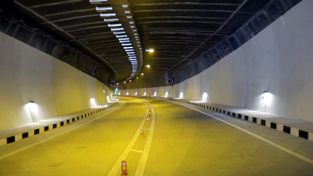Nishikant Khajuria
CHENANI, Mar 28: Chenani-Nashri tunnel, which is all set to be thrown open for vehicular movement with its formal inauguration by Prime Minister Narendra Modi on April 2, is not only India’s largest highway tunnel but also most intelligent one in the world.
Significant features like Integrated Traffic Control System (ITCS), Video surveillance through 140 CCTVs, wireless communication and FM broadcast system, Entrance Detection Control, Electrical Fire signalling, Active Fire Fighting, Tunnel Ventilation, Evacuative Broadcast system and SOS call boxes make it most intelligent tunnel of the world, which has been built in four years-again first in the world.
With the help of cross passages after every 300 meters, which lead to escape tunnel and through public address system or FM announcement, the evacuation of humans in case of any incident inside the main tunnel will be done within 90 seconds while in the second phase, the situation will be diffused in the next 90 seconds thus finishing the entire operation within three-four minutes.
Besides, there are SOS Call Boxes at every 150 meters inside the main tunnel, where immediate requirements such as first- aid kit are installed and the person on very entering the box will automatically get connected with control room for further instructions as well as inviting swift action by Route Patrolling Officers.
Thus, this state of the art engineering marvel in the most difficult terrain of Himalayas is fully automatic smart system control tunnel with no human intervention for the technical operation.
“Even as world class safety measures and fully integrated control system without human intervention are also installed in a few tunnels in the world, the fully transverse ventilation system in Chenani-Nashri tunnel makes its most intelligent and confines the incident within 100 meters unlike other tunnels,” said Ashutosh Chandwar, vice-president of Project Developer IL&FS Transport Network, while briefing mediapersons on visit to the tunnel.
Further, he added, in case of increased Carbon Mono-oxide and opacity level inside the tunnel, the sensors will automatically restore the ventilation system by opening fresh air and exhaust windows in the particular area.
Pertinent to mention that this 10.98 kms long Chenani-Nashri tunnel, which forms part of proposed widening of Jammu-Srinagar National Highway (NH-44), will be dedicated to the nation by Prime Minister Narendra Modi on April 2, 2017 at 3 pm.
The tunnel project comprises of a main tunnel and parallel escape tunnel, which are connected through 29 cross passages at every 300 meters. The main tunnel has 9.35 meter carriageway with vertical clearance of 5 meters and 1.30 meter walkway on either side. The parallel escape tunnel has 5 meters carriageway and 2.50 meter vertical clearance while cross passages are seven meter wide and 2.5 meter in vertical clearance.
“In total 19 km long excavation was done for main tunnel, escape tunnel and cross passage while 65 lakh cement bags and 12 lakh ton steel was used in the construction work, for which approximately 1200 persons remained engaged in each shift daily,” informed Ashutosh Chandwar.
This is Asia’s first and longest bi-directional highway tunnel, which will reduce the road distance between Chenani and Nashri from 41 kms to 10 kms and thus save time by about two hours as well as fuel saving to the tune of Rs 27 lakh per day.
Trending Now
E-Paper


